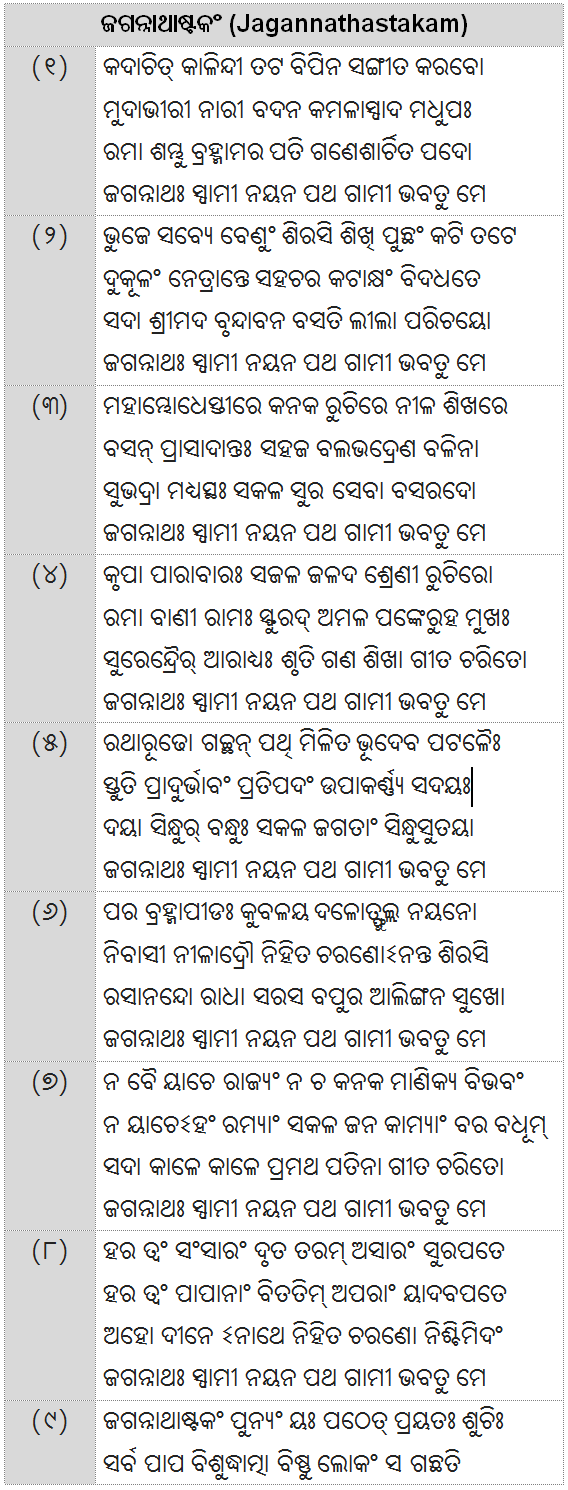LORD JAGANNATH
The word 'Jagannath' is a combination of two words 'Jagat' and 'Natha'. 'Jagat' means 'The Universe/World' and 'Natha' means 'Lord/Master', so the name Jagannath literally means 'Lord of the Universe'. Puri is the dwelling place of Lord Jagannath so this place is otherwise known as 'Jagannath Dham' or 'Jagannath Puri'.
In Sanskrit 'Ja' represents Jagannath, 'Ga' represents Balabhadra, 'Nna' represents Subhadra and 'Tha' represents Sudarshan, so Jagannath means the union of all four Deities of the Jagannath Temple. His arms are parallel, hence willing to embrace the devotees from all over the world and his eyes are round (Chakadola) without any eye lids, hence looking after the welfare of his devotees without any sleep. A familiar and lovable name of Lord Jagannath is 'Chakadola', meaning round eyes. The word 'Chakadola' is synonymous with 'Chakanayana', 'Chakaakshia'. Unlike those of Lord Balabhadra and Goddess Subhadra, the eyes of Jagannath are round in shape. The symbolic meanings of Chakadola are as interpreted by some eminent scholars - One of the Avataras (incarnations) of Lord Vishnu is Matschhya (fish) Avatara. Rohita (Rohi fish) and Animisha (having no eye-lids) are two names of Vishnu out of his one thousand names (Vishnu sahasra nama), which indicate Matschhya avatara. The round lid-less eyes, like that of fish, symbolise that Lord Vishnu or Lord Jagannath is ever active and vigilant for his devotees.
Everything related to Lord Jagannath is Bada (Big or any form of Greatness). He is known as the Bada Thakura (The Chief among all Gods). His Temple is known as the Bada Deula (The main temple among the temples). The road in front of the temple is known as Bada Danda (Grand Road). The Sea of puri is known as the Mahodadhi (Great Ocean). The cremation ground in Puri is known as Swargadwar (The Gateway to Heaven).
Centuries of myths, legends and history have all blended into a grand composite culture centred round Jagannath, the Lord of the Universe, one of the most revered and ancient of the Deities of the Hindu pantheon. The earliest references to Lord Jagannath are found in the Purans and ancient literature, though details of His origin and evolution are still surrounded in mystery. Legendary sources suggest that Jagannath was originally worshipped by the tribals, the Savaras who are considered to be of tribal lineage and who still play a major role in the various services to Lord Jagannath in the Jagannath temple of Puri.
In course of time, the cult of Jagannath took an Aryanised form and various major faiths like Saivism, Saktism, Vaishnavism, Jainism and Buddhism were assimilated into the concept of Jagannath as an all-pervasive and all-inclusive philosophy, symbolising Unity in Diversity.
Some scholars think that the three images of Jagannath, Balabhadra and Subhadra represent the Jain Trinity of Samyak Gyan, Samyak Charitra and Samyak Drishti. Many others say that the three images represent Buddhist Triad of Buddha, Dharma and Sangha. It is widely believed that the Soul of Jaganath, most secretly ensconced within the image of Lord Jagannath, is no other than the Tooth Relic of Lord Gautama Buddha. The philosophy of Tantra which in course of time became an integral part of Buddhism too has significantly influenced the rites and rituals of the Jagannath temple.
The cult of Jagannath is meant for universal brotherhood, love, tolerance and equality. One can find that the various castes, creeds, customs, traditions, communities and sects have been assimilated in Jagannath Dharma.
Different names of Lord Jagannath
Jagannath Astakam

| Content Navigation | ||
| Next Page | ||
|

